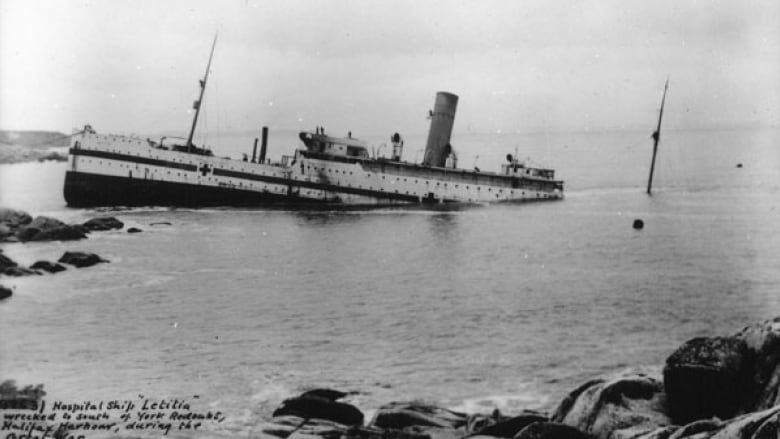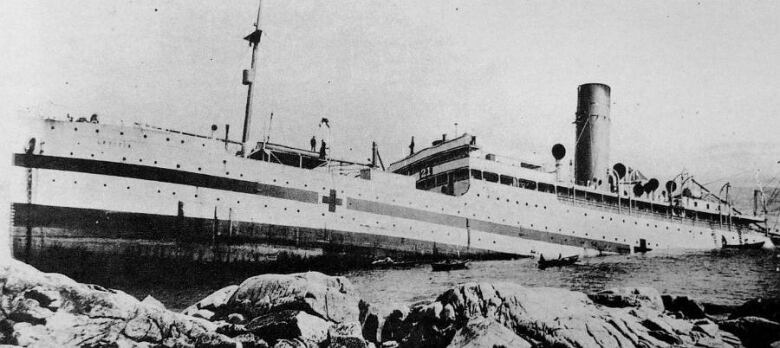100 years ago today, a ship carrying 546 wounded WW I soldiers ran aground off Halifax
Vessels swarmed to the disaster site to bring wounded soldiers ashore from the ill-fated vessel

The weather in Halifax harbour on the morning of Aug. 1, 1917, would seem very familiar to a sailor today. Thick fog covered the harbour approaches, reducing visibility to almost zero.
It was a Wednesday, and the hospital ship Letitia was carrying 546 wounded Canadian soldiers back home from World War I. It was a journey the ship had made several times, without incident. The Letitia was a big, modern liner built in 1912 to carry passengers between Scotland and Quebec.
But that Wednesday crossing was unlike its previous journeys.
Remarkable rescue operation
The crew of the Letitia listened for the bells ringing on the buoys marking the channel and for the foghorns of nearby lighthouses. Just like today, a harbour pilot came aboard to guide the ship past the rocks and shoals that claimed so many ships over the centuries.
After only a few minutes, the captain saw something dark looming through the fog. He ordered the engines to full astern, but it was too late.
The Letitia ran aground on the rocks of Portuguese Cove.

What followed was a remarkable rescue operation. Many of the soldiers on board were seriously wounded and could not move without help.
"Nearby vessels, including military vessels, minesweepers and other vessels, engaged in an effort to get everyone off," said Roger Marsters, curator of marine history at the Nova Scotia Museum.
"And they managed to get everyone off alive, which was quite a spectacular feat."
The captain and some crew remained on board until the next day, when it became obvious that the ship was too badly damaged to be pulled off the rocks. The remaining crew members then left the ship except for a stoker, who was accidentally left behind and then drowned as he tried to swim ashore. He was the only casualty.
Harbour pilot punished
The inquiry into the sinking focused on the actions of the pilot, Walter White.
Letitia's captain, William McNeil, described a conversation with the pilot, moments after the ship ran aground.
"I said when I went up, 'Well, you have done it now.' He said, 'Well, yes sir. It is too bad to think that you should bring your ship all the way across and me put her ashore here.' He seemed very sad about it."
Walter White was found guilty of a gross error of judgment and demoted.
The Letitia remained stuck on the rocks for months, battered by waves and storms, until it split in two, sinking into the harbour where it still lies today.
Anything of value on the ship was removed by both legal and illegal salvagers. It's now mostly remembered by divers, the wreckage ripped apart by the salvagers and the winter storms that sweep up the harbour.
'A success story'
But it's also commemorated by historians, with its own exhibit at the Maritime Museum of the Atlantic, because of its contrast with other marine disasters like the Titanic and SS Atlantic, where so many died.
"This was a success story in many ways. This was a situation in which the salvagers were in fact able to rescue hundreds of people who were in immediate peril of drowning," Marsters said.
"So it's a story that tells the other side of our maritime history and maritime endeavour, the successful side, the instances in which people were saved from the sea by virtue of the efforts of local people."
Another crash at same site
The remains of the Letitia were most recently disturbed, in a strange re-enactment of the original wreck, by a Japanese trawler that ran aground in exactly the same spot 14 years ago. That ship ended up resting on some of the Letitia's wreckage, but its ending was less dramatic. It was successfully towed off the rocks and repaired.
The inquiry into that accident was unable to find a reason why the trawler hit the rocks, but noted the captain had been drinking and no one was on watch or monitoring the vessel's position when it went ashore.













_(720p).jpg)


 OFFICIAL HD MUSIC VIDEO.jpg)
.jpg)



























































































